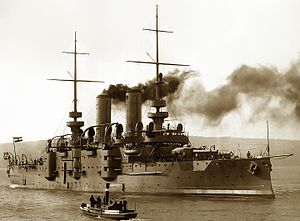SMS Babenberg
 SMS Babenberg in 1914
| |
| History | |
|---|---|
| Name | Babenberg |
| Namesake | House of Babenberg |
| Builder | STT |
| Laid down | 19 January 1901 |
| Launched | 4 October 1902 |
| Christened | Countess Marianne von Goess |
| Completed | 15 April 1904 |
| Fate | Scrapped, 1921 |
| General characteristics | |
| Class and type | Habsburg-class pre-dreadnought battleship |
| Displacement |
|
| Length | 375 ft 10 in (114.6 m) |
| Beam | 65 ft (19.8 m) |
| Draft | 24 ft 6 in (7.5 m) |
| Installed power | 16,000 ihp (11,931 kW) |
| Propulsion | 2 shafts, 4-cylinder Belleville boilers |
| Speed | 19.85 knots (36.76 km/h; 22.84 mph) |
| Complement | 638 |
| Armament |
|
| Armor |
|
SMS Babenberg[a] was a pre-dreadnought battleship built by the Austro-Hungarian Navy. She was launched on 4 October 1902 as the last of three Habsburg-class battleships. Along with her sister ships, she participated at the bombardment of Ancona during World War I. At the end of the war, she was given to Great Britain as a war prize. She was scrapped in Italy in 1921.
Construction and layout
Babenberg was the last of three battleships of her class. Her

Like all ships of her class, Babenberg was 113.11 meters (371 ft 1 in)
Babenberg was powered by 2-shaft, 4-cylinder vertical
The hull for the ship was constructed from longitudinal and transverse steel frames, over which the outer hull plates were
Babenberg had three
Service history
Peacetime
When Babenberg was commissioned in 1904, she began participation in fleet drills with her sister ships SMS Árpád and SMS Habsburg. Following a series of simulated wargames against the three Monarch-class battleships,[7] Babenberg and the other two Habsburg-class ships became the I Battleship Division.[8] With the commissioning of the Erzherzog Karl-class battleships in 1906 and 1907, the Habsburg-class battleships were transferred from the I to the II Battleship Division, and the three Monarch-class battleships were moved from the II to the III Battleship Division.[7]
World War I
During
Footnotes
Explanatory notes
- Seiner Majestät Schiff", or "His Majesty's Ship" in German.
Citations
References
- Blatchford, Robert (1904). "Sundries: A Socialist editor on conscription". The United Service Magazine. Vol. 150. H. Colburn.
- Gardiner, Robert; Chesneau, Roger; Kolesnik, Eugene M., eds. (1979). Conway's All the World's Fighting Ships 1860–1905. London: Conway Maritime Press. ISBN 978-0-85177-133-5.
- Halpern, Paul G. (1995). A Naval History of World War I. Annapolis: Naval Institute Press. OCLC 57447525.
- Hore, Peter (2006). The Ironclads. London: Southwater Publishing. ISBN 978-1-84476-299-6.
- Koburger, Charles (2001). The Central Powers in the Adriatic, 1914–1918: War in a Narrow Sea. Westport, CT: Greenwood Publishing Group. OCLC 44550580.
- Phelps, Harry (1901). "Notes on ships and torpedo boats, Section 2". Notes on the Year's Naval Progress, Issue 20. Office of Naval Intelligence, Government Printing Office.
- Sieche, Erwin (1985). "Austria-Hungary". In Gardiner, Robert; Gray, Randal (eds.). Conway's All the World's Fighting Ships 1906–1921. Annapolis: Naval Institute Press. ISBN 978-0-87021-907-8.
- Sondhaus, Lawrence (1994). The Naval Policy of Austria-Hungary, 1867–1918. West Lafayette, IN: Purdue University Press. OCLC 28112077.
- Tucker, Spencer E. (2005). The Encyclopedia of World War I. ABC-CLIO. ISBN 978-1-85109-420-2.
